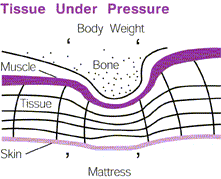What Are Pressure Ulcers?
A pressure ulcer is an injury usually caused by unrelieved pressure that damages the skin and underlying tissue. Pressure ulcers are also called decubitus ulcers or bed sores and range in severity from mild (minor skin reddening) to severe (deep craters down to muscle and bone).
Unrelieved pressure on the skin squeezes tiny blood vessels, which supply the skin with nutrients and oxygen. When skin is starved of nutrients and oxygen for too long, the tissue dies and a pressure ulcer forms. The affected area may feel warmer than surrounding tissue. Skin reddening that disappears after pressure is removed is normal and not a pressure ulcer.
Other factors cause pressure ulcers, too. If a person slides down in the bed or chair, blood vessels can stretch or bend and cause pressure ulcers. Even slight rubbing or friction on the skin may cause minor pressure ulcers.

Proceed to Next Section

